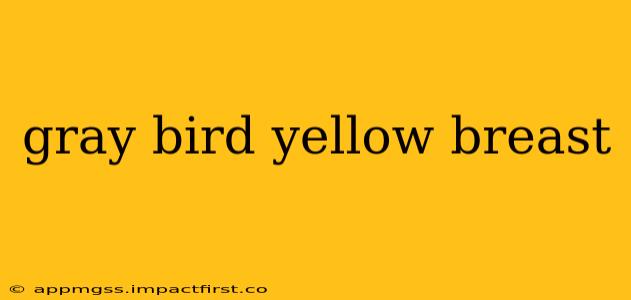Spotting a gray bird with a yellow breast can be exciting! Many species boast this striking color combination, making identification crucial for bird enthusiasts and casual observers alike. This guide will help you narrow down the possibilities, offering detailed descriptions and key features to aid in your identification. We'll also answer some frequently asked questions to enhance your birding experience.
What are some common gray birds with yellow breasts?
Several bird species exhibit a gray and yellow plumage pattern. The most common depend heavily on your geographic location. Some prominent examples include:
-
Yellow-breasted Chat: This large, secretive bird is known for its striking yellow breast contrasting with its olive-gray upperparts. Its long tail and distinctive song further aid identification. They are found in brushy habitats throughout much of the eastern United States and parts of Mexico.
-
Yellow-rumped Warbler (Audubon's and Myrtle's): These warblers, while exhibiting yellow on their rumps, often show yellow on their breasts, especially males. The back is a mix of gray and olive-green, depending on the subspecies and plumage stage. They are common throughout North America, migrating extensively.
-
Wilson's Warbler: This vibrant warbler features a bright yellow breast and belly, with gray-blue tones on its back and wings. The face is typically a darker gray. Found in western North America, it prefers coniferous forests.
-
Townsend's Warbler: This species is similar to Wilson's Warbler, also featuring a gray back and bright yellow breast. However, it has a distinctive black cap, helping distinguish it from Wilson's. It’s also found in western North America.
Remember that variations in plumage can occur due to age, sex, and seasonal changes. Therefore, relying on multiple identifying features is crucial for accurate identification.
How can I tell the difference between similar gray birds with yellow breasts?
Distinguishing between similar species requires careful observation of several key characteristics:
-
Size and Shape: Compare the overall size and body proportions. For example, the Yellow-breasted Chat is significantly larger than most warblers.
-
Head markings: Note any distinct markings on the head, such as a cap (Townsend's Warbler) or eye-rings.
-
Wing bars: The presence and color of wing bars are helpful. Some species have prominent wing bars, while others lack them entirely.
-
Habitat: The habitat where you observe the bird is a valuable clue. Different species prefer different environments.
-
Behavior: Observe the bird's behavior – foraging habits, flight patterns, and vocalizations.
What is the best way to identify a gray bird with a yellow breast?
The most effective approach is a multi-faceted one:
-
Careful observation: Take your time to observe the bird thoroughly. Note its size, shape, color pattern, and behavior.
-
Use a field guide: Consult a reputable field guide specific to your region. These guides contain detailed descriptions, illustrations, and range maps that are invaluable for identification.
-
Use online resources: Numerous online resources, including websites and apps dedicated to bird identification, can be extremely helpful. Upload photos for identification assistance.
-
Join a birding community: Connecting with local birders can provide valuable insights and assistance with identification.
Where can I find a gray bird with a yellow breast?
The location of your sighting provides crucial information. Knowing the habitat type (forest, woodland, brushy areas) greatly narrows down the possibilities. For example, Yellow-breasted Chats prefer dense brushy areas, while warblers are frequently found in forests and woodlands. Consulting range maps in a field guide will also help pinpoint likely species based on your geographic location.
What are some resources to help me identify gray birds with yellow breasts?
Several excellent resources can assist in your identification efforts:
-
Field guides: Sibley Guide to Birds, National Geographic Field Guide to the Birds of North America, and Peterson Field Guide to Birds are popular choices.
-
Online resources: Websites such as the Cornell Lab of Ornithology's All About Birds and eBird are excellent resources.
-
Bird identification apps: Merlin Bird ID and iNaturalist are user-friendly apps that can help identify birds from photos.
Remember, accurate bird identification takes practice. The more you observe and learn, the easier it will become to distinguish between similar species. Happy birding!
